#大正庵釜春
Text

#たべもの #うどん #大正庵釜春
田園や住宅地の長閑な郊外風景の中を愛環の高架は通っていて(愛環の路線は全線ほぼ高架になっています)、見ているとこまめに乗客も入れ替わっているようです。ほとんどが地域の方の日常生活需要なので、乗り通す人はそれほど多くないのではなかろうか。
今回は完乗が目的ではないので、岡崎駅の手前の中岡崎駅で下車しました。ちょうどお昼どきだったので、駅の近くにあるうどん屋さん、大正庵釜春さんでお昼ご飯にすることに。
有名なお店なのか、平日にも関わらず待ち列ができていました。味噌煮込みうどんが人気?なのか食べている人が結構多かったのですが、定番をいこう!ということで釜揚げうどんにしました。そして並ぶだけあって、さすがの美味しさ。もちもちのうどんで、シンプルだからこそ本当に美味しいうどんでした。

一応愛環に乗ったよ記録。↑

お腹も満たしたので駅近くをぶらついていると、八丁味噌の工場と売店を発見。工場見学も行っているようですが、平日は毎時00分からの開催とのこと。訪れたのが15分くらいだったので、これから45分待つのもな……と、今回は見送ることにしました。海外からの視察?(観光客という感じではなかった)なのか、欧米系の方が20人ほど売店にいて英語が飛び交う中、私たちはその中を掻い潜るようにしてミソスープのフリーズドライを購入するのでした。

しかしなんか建物がレトロというか凄い感じだぞ、と思って調べてみると、昭和2年に建てられたもののようです。少し前に関東大震災が起こっているので、耐震を意識した丈夫な建物になっているんだそうです。
10 notes
·
View notes
Photo
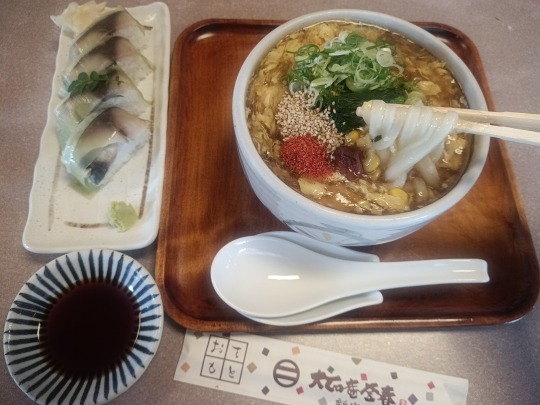
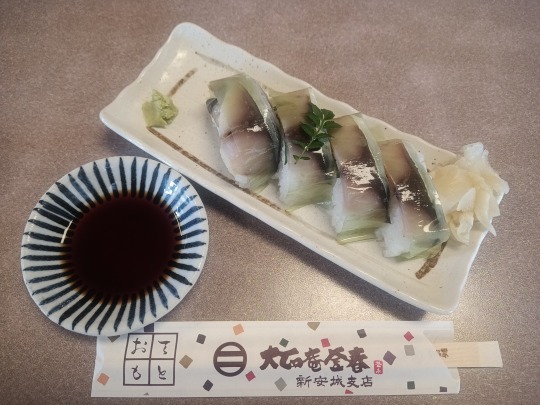

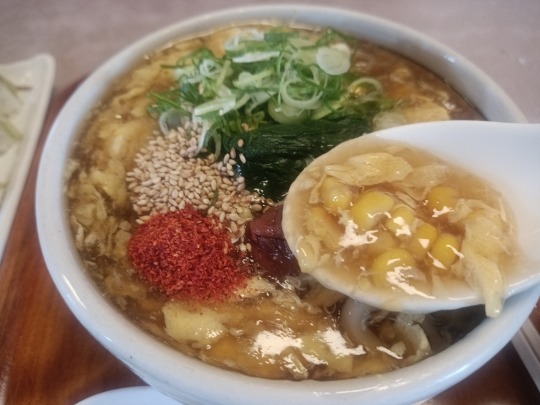

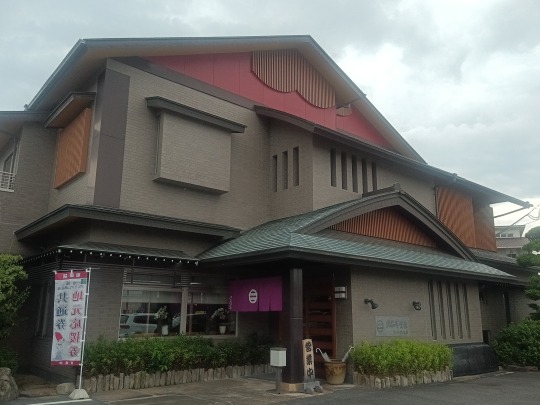
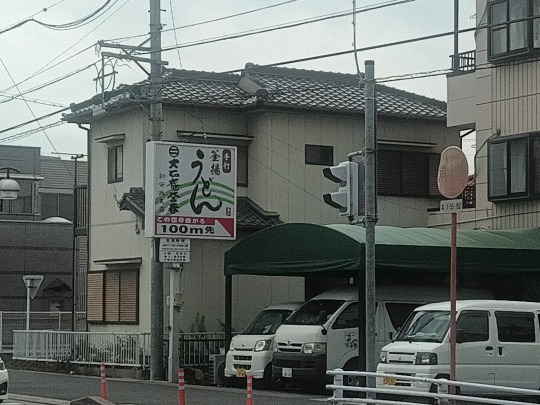
安城市篠目町4丁目の、大正庵 釜春 新安城店で、もろこしうどん930、鯖押し寿司850、〆て1,780円也。
Corn and egg starchy soup udon noodles and Mackerel pressed sushi at the Shinanjyo branch of Taishoan_Kamaharu, Yonchome, Sasamecho, Anjyo city, Aichi prefecture.
48 notes
·
View notes
Photo

#Repost @meaculpax3 • • • • • • 大正庵釜春 本店 味噌煮込うどん #大正庵釜春 #大正庵釜春本店 #岡崎市 #八丁味噌 #味噌煮込うどん #スワイプしてね #swipe #tankensurujapan (大正庵釜春 本店) https://www.instagram.com/p/B-N6qPCgVZ7/?igshid=thdwucmg253p
0 notes
Photo

岡崎にはチーズもろこし饂飩がある。 この後ネギをありったけぶっかけて×2回で。 めっちゃ旨い😋 #大正庵釜春 #udon #okazaki (大正庵釜春 本店) https://www.instagram.com/p/BuxZ8dFH8VY/?utm_source=ig_tumblr_share&igshid=wla2w1z1jitg
0 notes
Text
日本の輸出管理の運用変更を輸出規制と呼び、やめさせようと呼びかけている人のリストがこちらになります
呼びかけ人
<呼びかけ>(*は世話人) 2019年7月29日 現在78名
青木有加(弁護士)
秋林こずえ(同志社大学教授)
浅井基文(元外務省職員)
阿部浩己(明治学院大学教授)
庵逧由香(立命館大学教授)
石川亮太(立命館大学教員)
石坂浩一(立教大学教員)*
岩崎稔(東京外国語大学教授)
殷勇基(弁護士)
内海愛子(恵泉女学園大学名誉教授)*
内田雅敏(弁護士)*
内橋克人(評論家)
梅林宏道(ピースデポ特別顧問)
大沢真理(元東京大学教授)
太田修(同志社大学教授)
大森典子(弁護士)
岡田充(共同通信客員論説委員)*
岡本厚(元「世界」編集長)*
岡野八代(同志社大学教員)
荻野富士夫(小樽商科大学名誉教授)
小田川興(元朝日新聞ソウル支局長)
大貫康雄(元NHKヨーロッパ総局長)
勝守真(元秋田大学教員)
勝村誠 (立命館大学教授)
桂島宣弘(立命館大学名誉教授)
金子勝(慶応大学名誉教授)
我部政明(琉球大学教授)
鎌田慧(作家)
香山リカ(精神科医)
川上詩朗(弁護士)
川崎哲(ピースボート共同代表)
小林久公(強制動員真相究明ネットワーク事務局次長)
小林知子(福岡教育大学教員)
小森陽一(東京大学名誉教授)
在間秀和(弁護士)
佐川亜紀(詩人)
佐藤学(学習院大学特任教授)
佐藤学(沖縄国際大学教授)
佐藤久(翻訳家)
佐野通夫(こども教育宝仙大学教員)
島袋純(琉球大学教授)
宋 基燦(立命館大学准教授)
高田健(戦争させない・9条壊すな!総がかり行動実行委員会共同代表)
髙村竜平(秋田大学教育文化学部)
高橋哲哉(東京大学教授)
田島泰彦(早稲田大学非常勤講師、元上智大学教授)
田中宏(一橋大学名誉教授)*
高嶺朝一(琉球新報元社長)
谷口誠(元国連大使)
外村大(東京大学教授)
中島岳志(東京工業大学教授)
永田浩三(武蔵大学教授)
中野晃一(上智大学教授)
成田龍一(日本女子大学教授)
西谷修(哲学者)
波佐場清(立命館大学コリア研究センター上席研究員)
花房恵美子(関釜裁判支援の会)
花房敏雄(関釜裁判支援の会元事務局長)
羽場久美子(青山学院大学教授)
平野伸人(平和活動支援センター所長)
広渡清吾(東京大学名誉教授)
飛田雄一(神戸学生青年センター館長)
藤石貴代(新潟大学)
古川美佳(朝鮮美術文化研究者)
星川淳(作家・翻訳家)
星野英一(琉球大学名誉教授)
布袋敏博(早稲田大学教授・朝鮮文学研究)
前田哲男(評論家)
三浦まり(上智大学教授)
三島憲一(大阪大学名誉教授)
美根慶樹(元日朝国交正常化交渉日本政府代表)
宮内勝典(作家)
矢野秀喜(朝鮮人強制労働被害者補償立法をめざす日韓共同行動事務局長)
山口二郎(法政���学教授)
山田貴夫(フェリス女学院大学・法政大学非常勤講師、ヘイトスピーチを許さないかわさき市民ネットワーク事務局)
山本晴太(弁護士)
和田春樹(東京大学名誉教授)*
109 notes
·
View notes
Photo

岡崎まぜめん @ 大正庵釜春 本店(岡崎) 久しぶりの大正庵釜春。 今回は元祖「釜揚げうどん」でも、秘密のケンミンSHOWで紹介された「もろこしうどん」でもなくオカザえもんが好物という「岡崎まぜめん(1100円)」を。 岡崎の伝統的特産品である「八丁味噌」を使い、様々なジャンルや人が繋がる「まざりあい」を掛けたネーミングの新しい岡崎のご当地グルメ麺メニューだそうです。 食べていく途中で酢を加えると八丁味噌の味わいがマイルドになって二度美味しく感じました。 ごちそうさまでした。 #大正庵釜春 #岡崎まぜめん #岡崎まぜめんうどんver #八丁味噌 #岡崎 #オカザえもん #japan #酔生訓 (大正庵釜春 本店)
0 notes
Photo

釜揚げうどん at 大正庵 釜春 大行列。 超長い麺は釜のふちで箸使って切ります。御馳走様でした。 https://instagr.am/p/CdHxwVcvlMu/
0 notes
Text
明日のTVアニメ(地上波関東版)01/20言い訳不能版
今日の一言:募集中です。
※今日の一言を募集しています。アニメと無関係でも全然OKですが、改行は削除して1行にまとめさせていただきますので、予めご了承ください。
投稿は http://form.mag2.com/koutrethec から。
※メルマガ版ご購読の案内は http://www.mag2.com/m/0000064431.html まで。
~本日のnotes~
・特にありません。
※「本日のnotes」はあくまで雑記帳です。私が気が付かなかったことは書けないし、アニメとは無関係に言いたいことを書く時もあります。ご容赦を。
※当番組表は、しょぼいカレンダーさんのソースをもとに発行人がまとめ、編集委員会のメンバーで推敲しました。ですが、当然万全ではありませんので、番組表はあくまで目安と言う事で、あとは購読者の皆さんの側でご確認ください。
※この番組表は前日以前の発表に基づいて書かれています。正確な情報は当日の新聞や放送局サイトなどでご確認ください。
00:00
ソードアート・オンライン アリシゼーション #15「烈日の騎士」 [TOKYO MX]
00:00
ソードアート・オンライン アリシゼーション #15「烈日の騎士」 [群馬テレビ]
00:00
ソードアート・オンライン アリシゼーション #15「烈日の騎士」 [とちぎテレビ]
00:30
ハイスクール・フリート #3「パジャマでピンチ!」 [TOKYO MX]
00:30
ハイスクール・フリート #3「パジャマでピンチ!」 [群馬テレビ]
00:30
ハイスクール・フリート #3「パジャマでピンチ!」 [とちぎテレビ]
01:00
えんどろ~! #2「魔王、夕陽に散る~!」 [TOKYO MX]
01:30
W'z 《ウィズ》 #3「Cafe CUP PUCk《カフェ・カップ・パック》」 [TOKYO MX]
01:40
Hulu傑作シアター
※劇場アニメ「あした世界が終わるとしても」誕生のきっかけHuluオリジナルアニメ「ソウタイセカイ」をご紹介! [日本テレビ]
06:15
GO!GO!チャギントン [フジテレビ]
06:54
愛玩怪獣 #15 [テレビ東京]
07:00
FAIRY TAIL ファイナルシリーズ #292「明星」 [テレビ東京]
07:00
【新番組】おしえて魔法のペンデュラム~リルリルフェアリル~ #1「友達できるかな?」 [TOKYO MX]
07:30
ミッキーマウスとロードレーサーズ #29「ふたりはライバル/ハッピー・ヘルパー・ヘルパー」 [テレビ東京]
07:45
わしも-wasimo-(3) #31「わしも、かぜをひく」 [NHK Eテレ]
08:30
HUGっと!プリキュア #48「なんでもできる!なんでもなれる!フレフレわたし!」 [テレビ朝日]
08:30
デュエル・マスターズ! #41「極限ジョー態の攻防!暴走バラギアラの脅威!」 [テレビ東京]
08:30
レイトン ミステリー探偵社 #40「ジェラルディン・ロイヤーと最後の客」 [フジテレビ]
09:00
ゲゲゲの鬼太郎(2018) #40「終極の譚歌さら小僧」 [フジテレビ]
09:30
ワンピース #869「目覚めろ 最強を越える見聞色!」 [フジテレビ]
10:00
キラッとプリ☆チャン #41「春太のデート応援してみた!」 [テレビ東京]
10:30
日本の昔ばなし セレクション #41「分福茶釜/根子岳の猫/茶つぼ」 [テレビ東京]
11:30
バディファイト #29「決めろ!メガブラスト・バンカー!!」 [TOKYO MX]
17:30
きかんしゃトーマス [NHK Eテレ]
17:30
BORUTO #90「ミツキとセキエイ」 [テレビ東京]
18:00
ちびまる子ちゃん #1183 [フジテレビ]
18:00
ポケットモンスター サン&ムーン #105「ルガルガン決戦!サトシVSグラジオ!!」 [テレビ東京]
22:00
不機嫌なモノノケ庵 續 #3「行拶(ぎょうさつ)」 [TOKYO MX]
22:30
荒野のコトブキ飛行隊 #2「さすらいの6人」 [TOKYO MX]
23:00
シティーハンター2 #23「標的(ターゲット)はリョウ! 激写美人(フォーカスレディ)は危険が大好き!(後編)」 [tvk]
23:00
ワンパンマン #2「孤高のサイボーグ」 [TOKYO MX]
23:30
賭ケグルイ×× #2「百喰一族の女たち」 [TOKYO MX]
以下、21日
00:00
∀ガンダム #11「ノックス崩壊」 [チバテレビ]
00:00
ダンジョンに出会いを求めるのは間違っているだろうか #3「神様の刃(ヘスティア・ナイフ)」 [TOKYO MX]
00:10
【最終回】ツルネ #13「かけがえのない」 [NHK総合]
00:30
【新番組】マナリアフレンズ #1「アンとグレア」 [TOKYO MX]
00:45
だがしかし2 #3「ベーゴマと追憶と…」 [TOKYO MX]
00:55
その時、カノジョは。 #2「彼の失言」 [tvk]
01:00
パパだって、したい #3 [TOKYO MX]
01:35
ブラッククローバー セレクション #45「諦めの悪い男」 [テレビ東京]
0 notes
Link
大名鼎鼎的一風堂、一蘭拉面
想必大家都已經不陌生了。
它們的故鄉,正是在九州!
九州的面,因 ” 豚骨拉面 ” 而聞名,
但又遠遠不止這麼簡單。
在充滿期待的等待後,一鼓作氣地吃掉,
這才是在九州吃面的精髓!
one
福岡 · 博多拉面
湯清面扁方為正宗
平均價格:600 日元
我們在國內吃到最多日本拉面,就是各種以豚骨為湯底的拉面,那麼到九州的話,一定得到福岡縣的博多,去品嘗一下以豚骨湯聞名的正宗拉面。
一碗好的博多拉面,” 湯清 ” 和 ” 面扁 ” 是必要的。博多拉面的豚骨湯一般用豬腿骨和頭骨熬制,強火燉出骨膠,但湯頭依然清澈,湯味卻濃鬱。
搭配的基本菜餚是叉燒和蔥花,燉得酥軟的叉燒吸飽了濃醇湯汁。呼嚕呼嚕吃下一碗,唯一想說的是:” 老板,加面 “。
推薦店鋪:Uma 馬
福岡縣福岡市博多區園町 1-26
+81-92-271-4025
two
長崎 · 什錦面
頗具平衡感的華麗海鮮面
平均價格:800 日元
關於長崎什錦面的起源,有一段溫馨故事。1899 年,福建省出身的陳平順先生為了照顧當時的中國留學生,發明了便宜又營養的什錦面,因其味道鮮美而在留學生之間流行起來。
不久長崎市民也開始對這道美味感興趣,市區內一家家賣什錦面的店面陸續開張,什錦面從此成為長崎特產。
長崎什錦面又稱為 ” 八鮮 “,在一大碗湯面里頭加進叉燒肉、蝦、墨魚、筍幹、蕃茄、高麗菜、木耳等,不但山珍海味都有了,顏色也搭配得鮮艷誘人。
推薦店鋪:皇上皇
長崎縣長崎市尾上町 1-1 AMU PLAZA 5F
+81-95-808-1502
three
宮崎 · 釜揚烏冬
驚人鮮美的質樸烏冬面
平均價格:600 日元
釜揚烏冬從賣相開始就非常特別,兩個熱氣騰騰的碗,略大的那碗是原湯烏冬面,小的那碗則是特制醬湯,吃時需撈出面條放入熱醬湯中蘸一下。
醬湯的主要原料是沙丁魚汁,難怪口感極鮮,上面撒上天婦羅脆粒,讓面的口感更為豐富。客人點單後面才下鍋,保證其彈性與韌勁。
這看似樸素的面料理擁有出乎意料的鮮美,怪不得所有人都能三下五除二大口吃完呢。
推薦店鋪:織田薪
宮崎縣宮崎市中央通 2-23
+81-985-27-9984
four
佐賀 · 素面
日本面料理的尋常心
平均價格:500 日元
素面是用小麥粉做的一種細面,Q 彈筋道的面條,面香四溢,有點像日本版陽春面。
日本人習慣蘸著 ” 出汁 “(用魚骨等精心熬制出來的湯汁)吃冷的素面。
佐賀神崎的 ” 百年庵 ” 還有雞蛋、梅子、茶等不同口味的素面可選,女性朋友們一定得試試梅子味。
推薦店鋪:百年庵
佐賀縣神埼市神埼町 1779
+81-952-53-2853
five
鹿兒島 · 流水掛面
旋轉而出的冰鎮好面
平均價格:550 日元
把掛面放在冷水里轉幾圈就能變得好吃嗎?在鹿兒島指宿的唐船峽吃過後就知道,用地下湧出的清涼之水一圈一圈冰鎮煮好的掛面,確實美味。
這聽來是很夏令的美食,但當地人說唐船峽冬暖夏涼,冬季也有不少人前來,一年四季維持高人氣,每年約有 30 萬訪客慕名前來。
推薦店鋪:指宿市營唐船峽流水掛面
鹿兒島縣指宿市開聞十町 5967 番地
+81-993-32-2143
six
熊本 · 拉面
吃完之後讓人嚇一跳
平均價格:800 日元
所謂的熊本拉面,是在豚骨的基礎上加上雞骨熬制湯底,並選用偏硬的中等粗細面條。此外,在湯底里加入麻油或炸過的大蒜是其最大特徵。
但是當你把第一口送進嘴里,絕對會大吃一驚!豬骨湯的濃濃的香味,伴著大蒜的香味,一下子散開來,喝一口湯,會覺得很清爽,不會有粘膩之感,甚至後味也很清爽。配上這粗細剛好的面條,簡直美妙極了。
赤 NOREN 是一家創業了 39 年的老店,門口寫著 ” 元祖!熊本拉面 ” 的醒目看板是其標志。店里的蒜香拉面,據說這是人氣第一名的拉面哦!
推薦店鋪:赤 NOREN
熊本縣熊本市中央區新市街 8-1
seven
大分 · 別府冷面
韓風冷面的日式轉身
平均價格:650 日元
網紅冷面店 ” 胡月 ” 的店員說,其實這面的源頭是朝鮮冷面,而別府冷面將之轉化成了日系風格,以日式湯汁為基礎,口味清淡,並在面條本身發揮各家特長。
聽聞 ” 胡月 ” 的粉絲會從日本各地紛至遝來,用天然水熬制的湯汁和韌勁十足的粗面條,只要吃上一次就會讓人上癮。一口下肚,口腔里滿是齒頰留香的白芝麻,面條香氣隨之而來,單純的味道卻充分挑動起味覺的敏感度。
推薦店鋪:胡月
大分縣別府市石垣東 8-1-26
+81-977-25-2735
0 notes
Photo


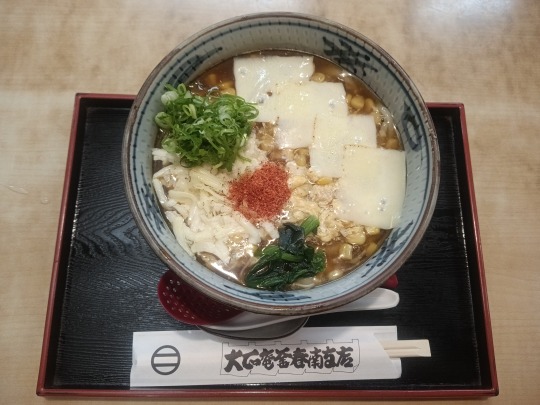


岡崎市若松東1丁目の、大正庵 釜春 南支店で、もろこしうどん1,023、チーズトッピング275、〆て1,298円也。
Corn egg starchy soup udon noodles topped with cheese at the Minami branch of Kamaharu, Okazaki city, Aichi prefecture.
33 notes
·
View notes
Photo

自粛明けて何が一番良いかって? チーズもろこしうどんが食べれる事に決まってる😋 #岡崎ソウルフード #釜春 #家康公が愛した食べ物それは柔らかいうどん (大正庵釜春 本店) https://www.instagram.com/p/CAzEaRkjwWp/?igshid=wxthpoc2t7zk
0 notes
Video
味噌煮込みうどん、寒い時は特に美味しい! #大正庵釜春 #味噌煮込みうどん #名古屋 #愛知県 #美味しい #うどん #味噌 #八丁味噌 #中岡崎 #instagood #instafood #instagram https://www.instagram.com/p/BtEsxgcgmI2/?utm_source=ig_tumblr_share&igshid=jl6z5cjz0n67
3 notes
·
View notes
Text
Nampō Roku, Book 2 (22): (1587) Second Month, Third Day, Midday.

22) Second Month, Third Day; Midday¹.
However, because of the lingering snow, water was not splashed in the roji².
◦ Three-mat room³.
◦ [Guests:] Daimonji-ya Yōsei [大文字屋養清]⁴, onaji Sōshun [同 宗春]⁵.
Sho [初]⁶.
◦ Tōyo [東與]⁷.
◦ Kama arare [釜 アラレ]⁸.
◦ On the tana:
◦ kan ・ habōki [鏆 ・ 羽帚]⁹.
▵ Shiru ko-kabu ・ tairagi [汁 小カブ ・ タイラキ]¹⁰.
▵ Tai ko-tsuki [鯛 子付]¹¹.
▵ Kuro-me [黒メ]¹².
▵ Ae-mono [アヘ物]¹³.
▵ Kashi iri-kaya ・ shiitake [菓子 イリカヤ ・ 椎茸]¹⁴.
[Go [後].]¹⁵
◦ In a basket, me-yanagi [メ柳]¹⁶.
◦ On the tana:
◦ chaire ko-natsume [茶入 小ナツメ]¹⁷.
◦ Mizusashi Seto [水指 セト]¹⁸.
◦ Hishaku [ヒシヤク]¹⁹.
﹆ Futaoki Rinzai [蓋置 臨濟]²⁰.
Su [ス]²¹.
◦ Chawan Mishima [茶碗 三嶋]²².
[The chawan was] placed inside the mentsu [メンツ] and brought in [from the katte, at the beginning of the temae]²³.
_________________________
¹Ni-gatsu mikka, hiru [二月三日、晝].
The Gregorian date of this chakai was March 11, 1587. It is early spring, with some hard-packed snow still lingering in the shaded places in the front garden of the Shū-un-an [集雲庵], where this gathering was held.
²Tadashi zan-setsu yue, roji mizu utazu [但殘雪故、露地水ウタズ].
Zan-setsu [殘雪] means “lingering snow,” and this refers to the hard-packed snow that remains in places that are shaded from the sunlight after all of the rest of the snow has melted.
While Rikyū's roji had very few tobi-ishi [飛び石] (stepping stones)*, the arrangement of the garden of the Shū-un-an (where this gathering took place) is not known†.
In order to protect the lingering snow, water was not splashed in the roji. It may have been poured over the stepping stones‡, however, if Rikyū felt this was necessary.
___________
*Rikyū's roji was primarily planted with turf grass. The garden had tobi-ishi only near the koshi-kake, in front of the chōzu-bachi, and under the genkan (leading up to the nijiri-guchi of the small room).
†The garden of the Shū-un-an, as a monastic residence, would not have been laid out like a roji (it having been built by Ikkyū Sōjun's illegitimate son Giō who is not known to have been a practitioner of chanoyu -- and, in any case, the concept of the roji did not exist before the middle years of Jōō's lifetime). Most likely, it had a fairly straight, paved path leading from the gate to the pair of shōji that were used as the guests' entrance -- since, as the leader of the monks, its resident would have been the frequent recipient of official communications from the abbot.
After the Shū-un-an was looted and burned down (according to the monks of the Nanshū-ji, by elements of the Imperial Army), the site was abandoned by the temple. And after the war, it was taken over by the Sakai City government, which erected (and still maintains) a kindergarten there.
‡According to Tanaka Senshō’s commentary.
The classical teaching was that water should not be splashed in the roji during the winter months, so the question would probably be whether Rikyū felt that the beginning of the Third Month fell into this category. (In Rikyū’s day, the Third Month was the last month when the ro was used. The change to the furo came at the beginning of the Fourth Month -- though some wabi-chajin continued to use the ro all year round.)
³Sanjō shiki [三疊敷].
As mentioned above, this was the Shū-un-an [集雲庵], the residence of Nambō Sōkei, which was located within the san-mon [山門], and between that gate and the outer wall of the Nanshū-ji.
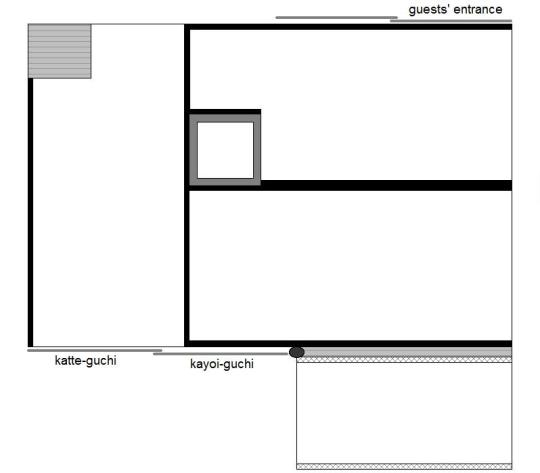
Because in this room the host faces the guests (albeit on a diagonal), it seems to create a feeling of intimacy which his 2-mat rooms may have lacked (since there is no real chance for eye-contact during most of their time together), Rikyū may have borrowed it when he had something important to discuss with his guests.
⁴Daimonji-ya Yōsei [大文字屋養清].
This refers to Daimonji-ya Yōsei [大文字屋榮清; his dates of birth and death are not known], though it appears that Rikyū has written the wrong kanji for “yō” [養, as opposed to 榮]*. He was an important machi-shū-chajin who had relocated his family from Sakai to Kyōto. The house was famously known to have been the owner of the Hatsu-hana katatsuki [初花肩衝], which Yōsei’s father presented to Oda Nobunaga in 1569. They also owned one of the most famous bokuseki written by the Song period Chán monk Xūtáng Zhìyú [虛堂智愚; 1185 ~ 1269] (pronounced Kidō Chigu in Japanese), which was therefore known as the Daimonji-ya Kidō [大文字屋虛堂]*.
___________
*This scroll is usually known as the yabure Kidō [破れ虛堂] -- “torn Kidō” -- today. This sobriquet derives from an episode that occurred later in the scroll’s history, when it was damaged (in the early Edo period, circa 1637) by an apprentice who worked in the Daimonji-ya establishment.

The scroll was very carefully repaired, and the damage is not apparent when the scroll is viewed from the usual distance.
⁵Onaji Sōshun [同 宗春].
This person has not been identified, though he was perhaps a younger brother of Daimonji-ya Yōsei*. As the family owned a number of very famous -- and enormously expensive -- tea utensils, it was likely that all of the sons cultivated an interest in chanoyu.
This is the only instance where Sōshun is mentioned in Rikyū's surviving kaiki.
___________
*Onaji [同] is not a surname -- as the various Japanese commentators suggest. It means that the surname is the same as for the previous guest -- this kaiki contains many abbreviations of this sort, because it was intended for no eyes but Rikyū’s.
⁶Sho [初].
The shoza.
In terms of kane-wari, the shoza was arranged as follows:
- the kakemono was displayed in the tokonoma by itself, so the toko was han [半];
- the kama was placed in the ro, making the room han [半] as well;
- and the go-sun-hane and kan were arranged side by side on the tsuri-dana, making it chō [��].
Han + han + chō is chō. This was appropriate because this chakai was taking place in the afternoon.
⁷Tōyo [東與].
This refers to a bokuseki written by the Yuan period Chán monk Dōnglíng Yǒng-yú [東陵永璵; 1285 ~ 1365]* (whose name is pronounced Tōryō Eiyo in Japanese).

Dōnglíng Yǒng-yú is said to have been related to the great Chán master Wúxué Zǔyuán [無學祖元; 1226年 ~ 1286] (Mugaku Sogen in Japanese). Both Wúxué and Dōnglíng emigrated to Japan in order to spread the orthodox Chán teachings.
Dōnglíng Yǒng-yú was a follower of the Sōtō sect [曹洞宗] of Chán; and, as mentioned above, he came to Japan in Shōhei 6 [正平六年] (1351). Although he was a monk of the Sōtō Shū, he served as the abbot (jūji [住持]) of a number of important Japanese temples that had no affiliation with that sect, among which were the Tenryū-ji [天龍寺] and Nanzen-ji [南禪寺] in Kyōto, and the Kenchō-ji [建長寺] and Enkaku-ji [圓覺寺] in Kamakura.
__________
*When writing this abbreviated version of his name (it uses the first and last of the four kanji), Rikyū has mistaken the second kanji -- writing yo [與], rather than yo [璵]. The first of these was, of course, the first syllable of Rikyū’s own childhood name (Yoshirō [與四郎]), and this may be the reason for his error.
⁸Kama arare [釜 アラレ].
This was Rikyū's ko-arare uba-guchi kama, made by Yoshirō, the kama-shi who appears to have returned with Rikyū from Korea.
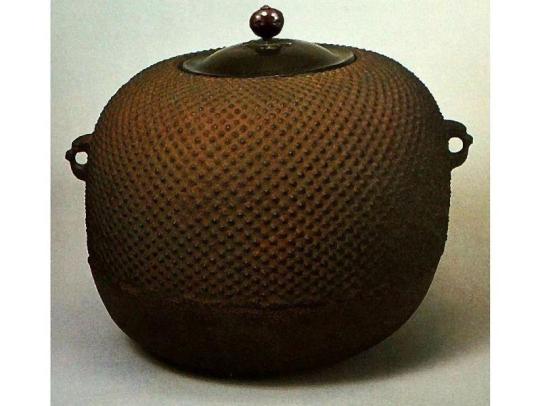
⁹Tana ni kan ・ habōki [棚ニ 鏆 ・ 羽帚].
The kan and habōki (a go-sun-hane [五寸羽]) were arranged side by side on the tsuri-dana.

The rule was that the habōki should always be closest to the wall when arranged in this way.
¹⁰Shiru ko-kabu ・ tairagi [汁 小カブ ・ タイラキ].
This was probably a clear soup (the turnip roots and scallops were boiled in ni-ban dashi, with the chopped leaves of the turnips added shortly before the soup was served so they would be crisp).
Ko-kabu [小蕪] are, as stated above, immature turnips*, both the leaves and roots of which were included in the soup.
Tairagi [たいらぎ = 玉珧] is commonly known as the Japanese scallop or comb pen-shell†. It is the kai-bashira [貝柱] (the muscle that opens and closes the shells) of this mollusk that is eaten. The scallops were cooked by being boiled in the broth in which they would be served.
__________
*Turnips were among the various brasscaceous plants usually grown in the kitchen garden as a source of fresh greens during the winter and early spring.
†Atrina pectinata.
¹¹Tai ko-tsuki [鯛 子付].
Tai [鯛] is the sea bream. Ko-tsuki [子付] means that the tai contained eggs -- which were considered a special delicacy.
While it is possible to grill the tai*, it seems that, more commonly, a sea bream that is gravid with eggs is cut into large pieces and boiled in flavored broth, or possibly steamed (either of which methods of cooking solidifies the egg mass so that it can be sliced). Thus, the tai was more likely a sort of ni-mono course.
__________
*And Kumakura Isao states unequivocally that the tai ko-tsuki was the yaki-mono. However, it must be understood that he is trying to interpret the kaiki in the Nampō Roku through the medium of 20th century Urasenke practices, and this highly regimented form is not really applicable to the nature of Rikyū's kaiseki.
¹²Kuro-me [黒メ].
Kuro-me [黒布], as has been mentioned before, is a type of seaweed that is eaten during the colder months. It somewhat resembles kelp, though it is a dark brown-black in color (hence the name, which means “black cloth”), rather than green. Kuro-me was usually served raw, dressed with a mixture of rice vinegar, sesame oil, soy sauce (or, perhaps, iri-zake), sugar, salt, and ginger juice.
¹³Ae-mono [アヘ物].
Ae-mono [和え物] is a salad-like dish, containing julienned vegetables (and sometimes fruits or fruit rind -- skin of the yuzu seems to have been popular during Rikyū's period), and occasionally finely sliced raw fish as well, all of which would be mixed together with a rice-vinegar-based dressing.
¹⁴Kashi iri-kaya ・ shiitake [菓子 イリカヤ ・ 椎茸].
Iri-kaya are the nuts of the Japanese allspice tree (Torreya nucifera)* that have been roasted (iri [煎り]) in a shallow pan over a charcoal fire.
Shiitake [椎茸] mushrooms, when being prepared for use as a kashi, are lightly salted while they are grilled on skewers over charcoal.
__________
*The kaya [榧] is also known as the Japanese nutmeg-yew. It is a coniferous tree in the family Taxaceae, in which the true yews (which the kaya resembles in its foliage) are also found. The seeds of the true yews (Taxus spp.) are toxic to humans -- as are all parts of the plant except for the fleshy aril (which surrounds the seed).
¹⁵Go [後].
This notation is missing from the Enkaku-ji version of the kaiki. From this point begins the description of the goza.
With respect to the kane-wari:
- the tokonoma contained the chabana, arranged in a bamboo hanaire that ws suspended on the back wall, and so was han [半];
- the room held the kama and the mizusashi, upon which was placed the hishaku, and with the futaoki standing in front of it (squarely placed on the kane), and so was chō [調];
- and the tea container -- a small natsume -- was placed in the center of the shelf, which removed it from contact with the kane, and so the tana was chō [調].
Han + chō + chō is han, which is correct for the goza of a gathering that is held during the daytime.
¹⁶Kago ni me-yanagi [籠ニ メ柳].
The basket was most likely Rikyū's Katsura-kawa kago [桂川籠], which would have been hung on the hook attached to the back wall of the tokonoma.

The flower was a budding branch of the weeping willow (me-yanagi [目柳 or 芽柳]*), arranged so that it arched toward the temae-za. While it is possible that the branch actually had willow flowers on it, more likely the "buds" were leaf buds -- to show the arrival of early spring.
__________
*This expression is an abbreviation. In full, it is me-bari-yanagi [目張り柳] -- which means a branch of weeping willow with the (leaf) buds starting to expand.
¹⁷Tana ni chaire ko-natsume [棚ニ 茶入 小ナツメ].
This would have been an ordinary black-lacquered small natsume*, tied either in a shifuku or in a small purple-dyed furoshiki (the model for the modern-day temae-fukusa).
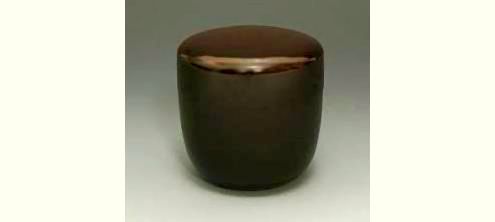
__________
*Tanaka Senshō -- apparently, in an effort to make the kane-wari come out as he wants it to -- decided that, in this entry in the kaiki (and unlike all other instances where Rikyū used the same formula), chaire ko-natsume [茶入 小ナツメ] means that Rikyū arranged both a chaire (of what sort it is impossible to imagine -- and Tanaka gives no hint of what he was thinking it might have been) and a ko-natsume (the latter for usucha -- which would also have been contrary to Rikyū’s usual practices) on the shelf: an argument which Kumakura Isao rather mindlessly apes in his interpretation of this chakai.
Shibayama Fugen argues (contrary to the way the kaiki is formatted) that the tana held not only the natsume, but also the futaoki and hishaku (which would hardly be treating the futaoki appropriately: but at least he interprets “chaire ko-natsume” to mean that “the chaire [was a] ko-natsume” as is consistent with Rikyū’s usual usage).
As I wrote earlier in this blog, I am of the opinion that the tsuri-dana -- as a direct derivative of the naka-dana of the fukuro-dana -- should partake of the fukuro-dana’s 7-kane system (even though the utensil mat, as a kyōma-datami, itself uses the 5-kane system). In such a case, displaying the ko-natsume in the center of the tana disassociates it from either of the kane that cross the shelf, thus making it chō [調] (the ko-natsume is 1-sun 9-bu in diameter), as can be seen in the sketch that follows footnote 19, below.
¹⁸Mizusashi Seto [水指セト].
This was Rikyū's Seto mizusashi, that had been made to Jōō's specifications (and originally intended for use on the fukuro-dana).

¹⁹Hishaku [ヒシヤク].
The hishaku was placed on top of the mizusashi, to lock its lid, with the handle extending toward the right -- as shown in the sketch of the utensil mat, below.

²⁰Futaoki Rinzai [蓋置臨濟].
This was the bronze name-seal that had been made for the great Chán monk Línjì Yìxuán [臨濟 義玄; ? ~ 866], on the orders of the Emperor of China. In the Enkaku-ji version of the text, this entry is marked with a red spot (shown here by a “﹆“ mark), to indicate that this is the “special utensil” that was used during this chakai.
This futaoki had originally belonged to Nōami [能阿弥; 1397 ~ 1471], and it was he that first used it as a futaoki -- and who laid down the rules for its use. This futaoki has not been mentioned since the early Edo period, and its whereabouts are not known.
Rikyū may well have determined the tori-awase for this chakai based on a desire to use this very special futaoki (given the great treasures associated with the Daimonji-ya house, the guests would probably have been disappointed had Rikyū used only ordinary things during this gathering), and his handling of it was intended to draw their attention to it*.
While Tanaka Senshō suggests that the Rinzai futaoki was placed on the left side of the mat, with the hishaku resting on it (and the handle of the hishaku parallel to the heri -- as is often done at the end of a temae), the arrangement shown in the sketch (above), with the futaoki squarely on the kane, seems more likely -- since it would afford the guests the chance to look at this precious futaoki when they entered the room for the goza. During the goza of this chakai, the futaoki was decidedly the highlight of the za, so Rikyū certainly would have displayed it in a way that called attention to its presence.
___________
*Displaying it by itself in the middle of the mat, as an hitotsu-mono [一つ物] (this expression -- which will be explained more fully in Book Six of the Nampō Roku -- means a meibutsu utensil that is displayed squarely on its kane, in order to call special emphasis to its special ranking) would have been inappropriate, since this object is merely the futaoki, not the chaire or chawan.
Nevertheless, it may have been because of the way that Rikyū arranged the futaoki that a small natsume was used, one that would fit between the kane when placed in the middle of the shelf.
²¹Su [ス].
The things mentioned after this notation were brought out from the katte at the beginning of the temae.
²²Chawan Mishima [茶碗三嶋].
This was Rikyū's Mishima chawan, which he seems to have brought back from Korea.
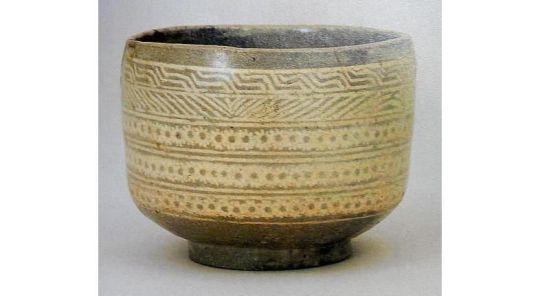
This bowl was originally made as an ordinary rice bowl.

Arranged in the chawan were the chakin, chasen, and a ori-tame [折撓] of Rikyū's own making (above -- though the chashaku is not actually mentioned in the kaiki), as usual.
²³Mentsu no uchi ni irete hakobu [メンツノ内ニ入テハコフ].
The chawan (containing the chakin, chasen, and chashaku) was placed inside a mentsū [面桶], and in this way all of these things were brought into the room in a single trip.
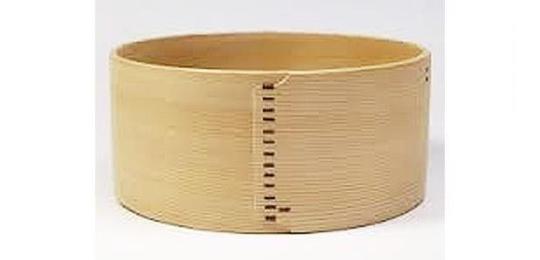
Since it was a rule that the host should minimize the number of trips between the utensil mat and the katte when serving tea in the small room -- and this idea seems to have included how many times he turned back from the temae-za to the katte-guchi -- placing the chawan inside the mentsū (which was always brand new) made the beginning of the temae simpler.
0 notes
Text
Nampō Roku, Book 2 (18): (1587) First Month, Fifth Day, Midday.

18) First Month, Fifth Day; Midday¹. Ne-no-hi [子日]².
◦ Three-mat room³.
◦ (Guests:) Hino dono [日野殿]⁴, Yūsai [幽齋]⁵, Sōkyū [宗久]⁶.
Sho [初]⁷.
﹆ In the toko, on an ashi-tsuke [足付]⁸ noshi-awabi [ノシアワヒ]⁹ ・ ne-matsu [根松]¹⁰.
◦ Kama unryū [釜 雲龍]¹¹.
◦ On the tana:
◦ in a fukube [フクベ], the charcoal¹²;
◦ habōki [羽帚]¹³.
▵ Shiru uguisu-na [汁 鶯ナ]¹⁴.
▵ Namasu tori [鱠 鳥]¹⁵.
▵ Kuro-me ・ kushi-awabi [黒メ・串鮑]¹⁶.
▵ Ao-ae・suzuna [青アヘ・スヽ菜]¹⁷.
▵ [Kashi] fu-no-yaki ・ shiitake [フノヤキ・椎茸]¹⁸.
[Go [後].]¹⁹
◦ Kokei Shun-fū [古溪 春風]²⁰.
◦ Chaire ryugo [茶入 リウコ]²¹.
◦ Tsutsui ori-tame [筒井 折タメ]²².
◦ Mizusashi Shigaraki [水指 シカラキ]²³.
◦ On the tana:
◦ hane [羽]²⁴.
_________________________
¹Shōgatsu itsu-ka, hiru [正月五日、晝].
The date was February 12, 1587, in the Gregorian calendar.
People usually spent the first four days alone with their family in their homes, and began to receive guests from the fifth.
Perhaps because members of his extended family were staying in his Ima-ichi machi residence, Rikyū borrowed Nambō Sōkei's Shū-un-an to receive this small group of friends.
²Ne-no-hi [子日].
This was the first Day of the Rat (the meaning of ne-no-hi) of the year.
◦ It was on this day that the Seven Grasses of Spring were collected (in the fields) and served during the meal.
◦ At this time, seedling pines were also collected, and displayed (and exchanged, as wishes for a long life).
◦ It was also the day when people gathered to enjoy group activities (things done for pleasure, such as playing games; and also chanoyu) for the first time in the year.
Rikyū observes these precedents during this chakai.
³Sanjō shiki [三疊敷].
This refers to the Shū-un-an [集雲庵], Nambō Sōkei's official residence in the Nanshū-ji in Sakai, a short walk from Rikyū's Ima-ichi machi home.
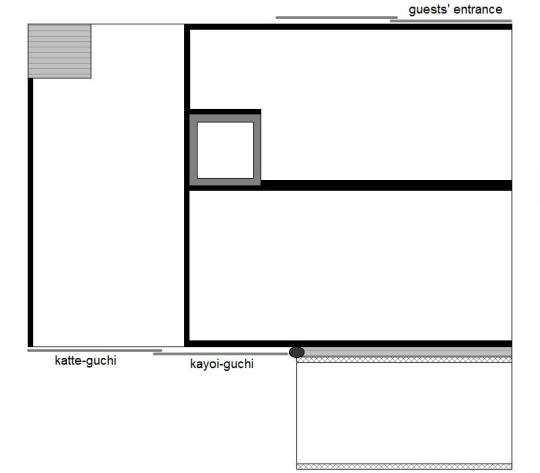
The Shū-un-an was a three-mat room, with the ro cut in the mat on which the lower guests sat. It was thus used as if it were a two-mat daime room.
This room contained the original tsuri-dana that was suspended in the left corner of the utensil mat, and so was known as the Shū-un-an-dana [集雲庵棚]. Rikyū appreciated the effect, and subsequently incorporated this kind of tana in his 2-mat rooms with a mukō-ro.
⁴Hino dono [日野殿].
This refers to Lord Hino Terusuke [日野輝資; 1555 ~ 1623], a kuge [公家]*, who, at the time of this chakai, was a gon-chūnagon [権中納言] or (supernumerary) Middle Counselor. Later this year (Tenshō 15 -- 1587) Lord Hino would be elevated to gon-dainagon [権大納言], (supernumerary) Major Counselor, and receive the senior grade of the Second Rank.
Lord Hino (who was born the same year that Jōō died) was also one of Rikyū's personal students.
__________
*A court noble. Lord Hino was a hereditary nobleman (he was the 28th head of his house), rather than someone who had been raised up from the military caste (as was the case with most of the nobles surrounding Hideyoshi).
⁵Yūsai [幽齋].
This was the daimyō and scholar Hosokawa Fujitaka [細川藤孝; 1534 ~ 1610], who was known as Yūsai [幽齋] after his retirement*. He was originally a champion of the Ashikaga shōgunate, and later offered his allegiance to Oda Nobunaga and, subsequently, to Hideyoshi as Nobunaga’s successor†.
As a literary scholar Hosokawa Fujitaka’s fame is well known; and it was natural, and almost unavoidable, that they would be intimate colleagues during Rikyū’s years of service to Hideyoshi‡.
___________
*As a direct consequence of the events leading up to Nobunaga’s seppuku. Hosokawa Fujitaka's son and heir was married to the daughter of Akechi Mitsuhide, and so he should have joined Mitsuhide in his rebellion against Nobunaga -- this was the expected behavior in this kind of situation. Nevertheless, Hosokawa Fujitaka decided to shave his head and became nyūdō [入道], taking the name Yūsai; with which act he surrendered his status as a daimyō to his son (though, since he was still considered to be the head of the family, his decision to refuse to join Mitsuhide would obviate his son from being pressed into capitulating to Mitsuhide's demands).
†Hosokawa Fujitaka’s refusal to participate in the battle of Yamazaki probably helped to secure the victory for Hideyoshi, since it kept his retainers from participating on the side of Mitsuhide. As a result, though Fujitaka was technically retired, he was encouraged to remain active both politically and culturally, and in these capacities he served as an advisor to Hideyoshi to the end of his lifetime (for which Hideyoshi rewarded Fujitaka with an income and land in Yamashiro Province in 1586; which was doubled again in 1595).
Nevertheless, his allegiance to Hideyoshi aside, Fujitaka supported Tokugawa Ieyasu (perhaps due to a personal dislike for Ishida Mitsunari and his schemes -- one of which resulted in the death of Fujitaka’s son’s wife and his granddaughter), for which the family was honored by the Tokugawa bakufu.
‡Which support persisted even after Rikyū’s death: the reason why it was his son who went to the bank of the Yodo River to “see Rikyū off” was not because of a lack of affection or esteem on his part, but so that Fujitaka would be in a position to ward off any attacks (on either Rikyū, or Fujitaka’s own family) from Hideyoshi that this gesture may have precipitated.
⁶Sōkyū [宗久].
This was Imai Sōkyū [今井宗久; 1520 ~ 1593], who, together with Rikyū and Tsuda Sōkyū, was regarded as one of the three greatest chajin of the age.
At the time of this gathering, Imai Sōkyū was still on friendly terms with Rikyū*, and so he was present at this, Rikyū's first (public) chakai of the year.
__________
*Their falling out would not occur until Rikyū was informed that Sōkyū had pocketed the proceeds received from the sale of a number of Jōō's antiques -- money which Rikyū (who had apparently encouraged Hideyoshi's generosity for this reason) had assumed would be turned over to Jōō's son and heir Sōga.
⁷Sho [初].
The shoza.
With respect to the kane-wari:
- the toko contains a low stand on which are arranged several seedling pines festooned with noshi-awabi*, and so is han [半];
- the room contains the kama in the ro, and so is han [半];
- and the tana holds the sumi-tori, with the habōki placed beside it, each of which is in contact with a yang-kane, so that the tana is chō [調].
Han + han + chō is chō, which is appropriate for the shoza of a chakai held during the daytime.
__________
*The muscle of an awabi (abalone) cut in such a way that it can be stretched out in a single, long strip, and then dried (with the upper end left in a slight coil, it looks like the kana no [の] and shi [し]). This is explained below under footnote 9.
Because of the important significance of the seedling pines (the pines and noshi on the small table functions as the chabana during this chakai), Rikyū has reversed the order of things, and displayed the “chabana” first. It remains in the tokonoma until the end of the gathering.
⁸Ashi-tsuke ni [足付].
An ashi-tsuke [足付] is an ancient style of square, unpainted, mage-mono tray, with two pieces of wood attached to the bottom as legs.

This kind of low tray-table was originally used when making offerings to the God of a shrine; here it is offering the seedling pines to the guests.
⁹Noshi-awabi [ノシアワヒ].
A noshi [熨斗] (the word literally means “smoothed out flat”) is a long strip of awabi that is cut in a special way (shown in the sketch, below: this way of cutting was considered a sort of magic, since it results in a single strip) which was then stretched out and dried (it then had the consistency of thin parchment).
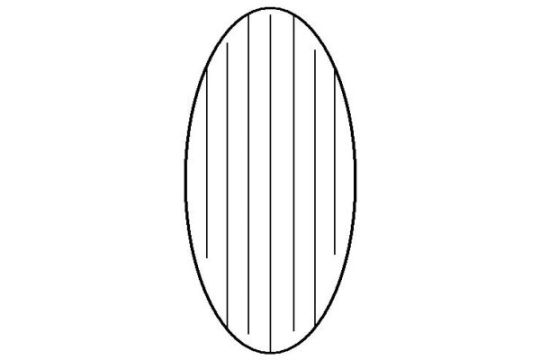
A noshi* was attached to gifts, and signified a gift given without expectation of any return. In this case, the noshi is attached to one (or perhaps several) seedling pines, the implication being that the host is offering his guests the gift of a long life.
__________
*At present the strip of dried awabi is reduced to a tiny snippet, which is enclosed in an elaborately folded envelope (with only one end of the noshi visible) -- or absent entirely (replaced by a printed representation of the noshi in its envelope).
¹⁰Ne-matsu [根松].
Ne-matsu [根松]* were small pine trees that were uprooted, and their roots were washed clean of soil.

They were offered to the guests on the Day of the Rat† (who may have taken them home at the end of the chakai and planted them in their garden) as a wish for long-life.
__________
*The word means pines (matsu [松]) with roots (ne [根]). Because the pine tree was said to live for a thousand years, this longevity was considered to be already encapsulated in the seedling. Thus collecting the seedlings from the wild was like harvesting longevity; and giving the seedlings to other people was like passing this long life on to them.
†Ne-no-hi [子日]. There are various word-plays (the result of homonyms) involved in the things associated with this day.
¹¹Kama unryū [釜 雲龍].
This was Rikyū's second small unryū-gama, which he asked Yojirō to cast after he presented Hideyoshi with the original small unryū-gama. While the original had a beaten-copper lid, this had a similarly-shaped lid cast of iron (bronze-making was not introduced to Japan until the mid-1590s).
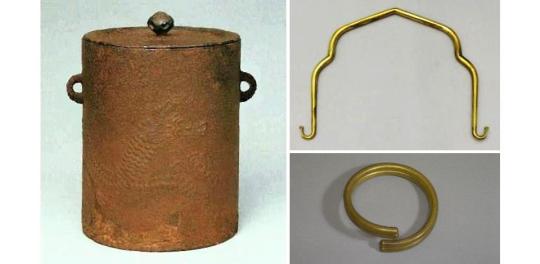
The kama was suspended over the ro on a bamboo jizai. Because this kama boils quickly, this would help insure that he inconvenienced Nambō Sōkei as little as possible.
¹²Fukube ni sumi [フクベニ炭].
Rikyū's fukube sumi-tori was rubbed with black lacquer.

Fukube [瓢] sounds like the word for good luck. Together with the ne-matsu, Rikyū is wishing his guests fortune and long life.
¹³Habōki [羽帚].
This would have been a go-sun-hane [五寸羽], such as was usually used in the small room.

Traditionally go-sun-hane were made from the feathers of the shima-fukurō [嶋梟], a fishing owl with black and rust-orange striped feathers.
¹⁴Shiru uguisu-na [汁 鶯 ナ].
Uguisu-na [鶯菜] is a somewhat smaller variety of komatsu-na [小松菜]* (Brassica rapa var. perviridis, a form of the plant from which rape-oil is derived): it has longer petioles and somewhat shorter leaves than komatsu-na, while the lower stem of uguisu-na swells more than is the case with komatsu-na†.
Uguisu-na is generally used whole (the roots, however, are removed), with the swollen lower end of the stem pealed (so it resembles a tiny, white radish) and intact. These greens are blanched in the soup. One or two of these would be placed in each bowl of miso-shiru.
__________
*The name komatsu-na [小松菜] refers to the village of Komatsugawa [小松川], located in Edogawa-ku [江戸川区] in Tōkyō, where this vegetable was heavily cultivated during the Edo period. The plant itself looks like a miniature Chinese cabbage without the bulk, and is referred to as "Japanese mustard-spinach" in English.
†This seems to be one of uguisu-na’s defining characteristics, and, regardless of the size, the presence of a small, white, radish-like swelling is important when uguisu-na is served.
¹⁵Namasu tori [鱠 鳥].
According to the account in the Edo period Ryōri Monogatari [料理物語]*:
"tori namasu: either wild goose (gan [鴈]) or duck (kamo [鴨]) may be used. The body is cut into two or three pieces, the fat and skin are removed, and the flesh should then be cut as thinly as possible. [The flesh] is rinsed in heated sake†, after which this sake should be thrown away. Depending on [the the host -- or the guests' -- preference], a little rice-vinegar may be added [to the sake in which the flesh was washed].
“It is suitable to serve the previously described fowl as kake-ae [かけあへ]‡; and wasabi [わさび = 山葵] and/or hana-katsuo [花かつを]** may be added. Adding a little [sliced raw] fish of any sort can also be good.”
In this case, the prepared fowl would have been mixed with julienned daikon and carrot, and dressed with a mixture of rice-vinegar, soy-sauce or iri-zake, sake, and mirin.
__________
*The URL for this account in the on line version of this text is:
http://base1.nijl.ac.jp/~kojiruien/inshokubu/frame/f000205.html
†This “washing” is similar to the way carp is “washed” in hot water for koi-arai [鯉洗い]. The flesh is removed as soon as it starts to firm.
However, given that the duck or goose would have been sliced as thinly as possible, the flesh would be more cooked than “raw” -- perhaps the fowl could be considered parboiled at this stage.
‡Kake-ae [掛和え] is something similar to namasu, though it includes many other types of fruits and vegetables, and usually a stronger-tasting (sometimes sesame oil based) dressing.
**Hana-katsuo [花鰹] is katsuo-bushi that have been scraped into thin pieces the size of cherry-blossom petals.
¹⁶Kuro-me ・ kushi-awabi [黒メ・串鮑].
Kuro-me [黒布] is a kind of seaweed that is served raw (if first dried, it is reconstituted by soaking in water), with a dressing made from a mixture of rice vinegar, sesame oil, soy sauce (or iri-zake), sugar, salt, and ginger juice.
Kushi-awabi [串鮑] is abalone that has been dried on a pair of bamboo skewers (to keep the muscle flat). It is rehydrated by boiling in broth before being sliced and served.
Both of these foods were traditionally served with sake.
¹⁷Ao-ae ・ suzuna [青アヘ・スヽ菜].
Ao-ae [青韲え] is described in the Ryōri Monogatari [料理物語]* as follows:
“dried sea-cucumbers† are thoroughly boiled in dashi [and then sliced or chopped into small pieces]. Ao-mame [青豆]‡ are grated, and [the resulting paste is] salted to taste. Then the two are combined.”
Suzuna [菘]** refers to immature kabura [蕪] (turnip), another Brassicaceous vegetable and one of the “Seven Grasses of Spring.” The suzuna may have been pickled in a manner similar to na-no-hana tsuke [菜の花漬け]: the suzuna would have been cut into pieces and quickly blanched in salted water, then rinsed in cold water and squeezed to remove the excess water. The suzuna together with a small piece of dried kombu, and perhaps a small red pepper, were placed in salted water (about 3 grams of salt to 100 ml of water), and kept in a cold place (the pickling solution should never freeze) for one day.
However, rather than served as separate dishes, Tanaka Senshō says that the coarsely chopped suzuna was parboiled and then mixed into, or dressed with, the ao-ae††.
__________
*The URL is the same as under footnote 15.
†Iriko [海参], several species of sea slug, with usually dark brown to black bodies with small papillae (horn-like appendages) scattered over the upper side. While they can be eaten fresh, they were often dried and then reconstituted by boiling in water or broth.
‡Ao-mame [青豆] are large green soybeans. The soybeans are boiled in the pod, and then, after removing them from the pod, they are grated (or perhaps “mashed” might be a better word) in a suri-bachi [擂鉢], into a thick paste. The salted paste is used as a dressing for the boiled and sliced sea cucumbers.
**According to Shibayama Fugen, the kanji was also be pronounced tōna [とうな = 菘].
††In which case the iriko would have had to have been chopped into much smaller pieces.
Precisely how Rikyū may have prepared this dish -- and whether this represented one offering or two -- is not clear from his kaiki.
¹⁸Fu-no-yaki ・ shiitake [フノヤキ・椎茸].
Fu-no-yaki [麩の燒] were Rikyū's small wheat-flour crêpes, spread or brushed with white miso, and rolled or folded into bite-sized pieces.
Shiitake [椎茸] mushroom caps were skewered on a pair of bamboo brochettes and grilled over charcoal, lightly salted, and so served.
¹⁹While what follows refers to the goza, Rikyū* apparently neglected to note this.
Though the utensil mat in the Shū-un-an was a maru-jō [丸疊] (a full-sized mat), it is used as if it were a daime -- and, further, the mizusashi was supposed to be positioned as if there were a sode-kabe (though none is present). Thus, it is placed 13 or 15 me from the right heri (depending on the size of the mizusashi†).
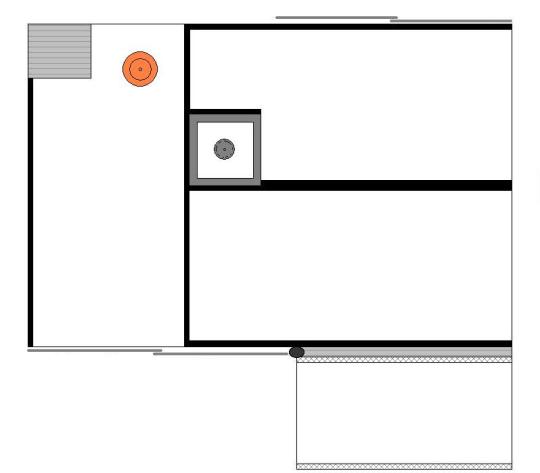
As for the kane-wari:
- in addition to the ashi-tsuke (bearing the ne-matsu and noshi-awabi), the kakemono was added to the toko, so it was chō [調];
- the room contains the kama in the ro, as well as the mizusashi, with the chaire and chawan arranged side by side on the mat (however, as in the daime-gamae, the chaire and chawan were not associated with the mizusashi, and so all were counted separately), making the room chō [調];
- meanwhile, the tana holds the habōki (which was resting on the kane closest to the wall), making it han [半].
Chō + chō + han is han, which is the proper character for the goza of a chakai held during the daytime.
__________
*Or, perhaps, Tachibana Jitsuzan inadvertently omitted it from his copy of this kaiki.
†A wider mizusashi is placed 13-me from the heri, while a narrower mizusashi is placed 15-me from the heri. According to Kanshū oshō-sama, this is a secret teaching that has been handed down from Nambō Sōkei.
When a sode-kabe is present, the mizusashi is placed 9-me from the heri, according to the Hundred Poems of Chanoyu:
◎ nijō-dai, sanjō-dai no mizusashi ha, saki ku-me ni oku ga hō nari [二疊臺、三疊臺の水さしは、先九目におくが法なり]: “in a 2-mat dai[me] or 3-mat dai[me room], the rule is that there should be 9-me at the edge.”
²⁰Kokei Shun-fū [古溪 春風].
This refers to the ichi-gyō-mono [一行物] featuring the kōan [公案] Shun-fu ichi-jin [春風一陣] that Rikyū had received from his Zen master, Kokei Sōchin [古溪宗陳; 1532 ~ 1598].
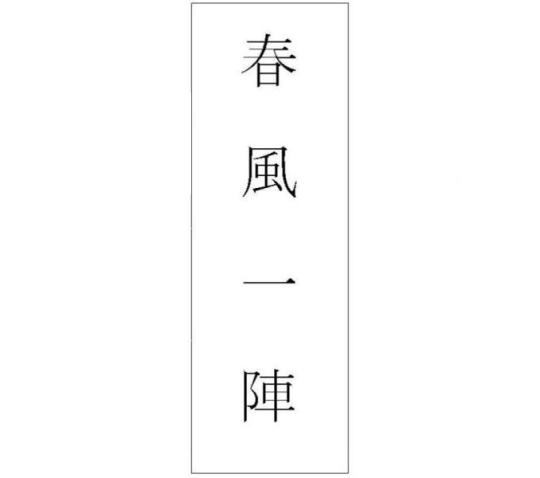
²¹Chaire ryugo [茶入 リウコ].
According to Tanaka Senshō, Rikyū is phonetically spelling the word ryūgo [立鼓] (“standing drum”), as a reference to a drum-shaped karamono chaire (rather than an hourglass-shaped tsuzumi [鼓], a small hand-held drum -- which is the usual image suggested by the word ryūgo [立鼓] -- this drum is a taiko [太鼓], a large barrel-shaped drum that is stood on its side: a pair of drummers face each drum-head and beat their respective heads of the drum simultaneously, the sound of which was considered to chase away evil spirits away). A karamono ryūgo-chaire [立鼓茶入]* of this sort is shown below.
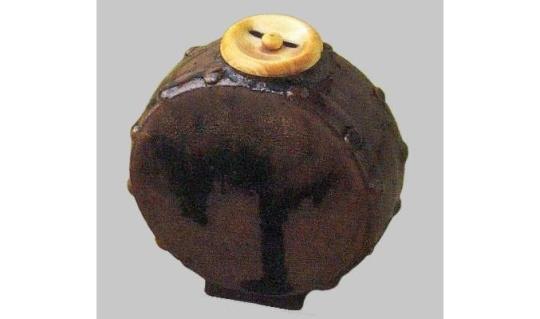
However, Shibayama Fugen, in his commentary, suggests that the name Rikyū is writing is the homophonous ryūgo [立觚], which referred to a ceremonial wine-cup of the type used on the continent for toasting (this kind of vessel had a bulbous bottom and a narrow neck, to keep the “wine†” as hot as possible, and a flaring mouth).
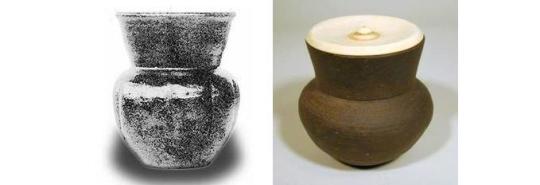
This kind of tea container is today known as an ankō-chaire [鮟鱇茶入]‡. However, that name was coined by Kobori Masakazu (Enshū), though several chaire of this type** had been used at least since the sixteenth century (and what they had been known as before his time has been lost††).
__________
*In China, this was a gift container for some sort of medicinal liquor (the drum probably being a sort of trade mark of the house that bottled the liquor). The surviving examples seem to have been made in molds, rather than hand-shaped, and are probably Ming.
†Actually it was similar to sake (which is technically a beer), though it was flavored with medicinal herbs.
‡The name ankō [鮟鱇] refers to a variety of fish known in English variously as the monkfish or goosefish (anglerfishes in the family Lophiidae). These fish have very wide mouths with which they suddenly envelop prey that are attracted by a fleshy, worm-like lure that is suspended in front of the mouth from the modified first spine of the dorsal fin.
**In addition to the karamono piece shown above (on the left), chaire of this shape were also being produced at the Seto kilns during the first half of the sixteenth century (if not earlier).
Today, most examples seem to be from Takatori [高取燒], one of the kilns personally patronized by Enshū -- though the shape is actually found in the earliest native pottery (the so-called Sue-ki [須恵器], which was being fired in both the southern areas of Korea, and in Kyūshū, from the third to ninth centuries: above, the photo on the right is a piece of this type).
††When faced with this sort of question, it is important for the reader to remember that, prior to Jōō (who was the first real “collector” after Ashikaga Yoshimasa -- though in Yoshimasa’s case, it was not so much that he was a collector, but that he made use of tribute that had been accumulating in the shōgunate’s treasure-houses for decades, on the direction of his dōbō [同朋], his foreign-born cultural advisors, who discovered these things during their inventory of the storehouses, and then informed Yoshimasa of the way these things had been used in Korea) virtually all chajin owned only one of each of the necessary utensils, and it was with that single set of things that they performed chanoyu throughout the year, and over the course of their lifetimes. Pieces that matched the established types (the various named sorts of ko-tsubo [小壺], and the large katatsuki [肩衝]), were referred as such, and their owners were ranked as suki-sha [数奇者]; and pieces that were not so-identifiable were left without a designation, and simply referred to as so-and-so’s chaire (if such things were mentioned in the records at all), and their owners were considered to be wabi suki-sha [ワビ数奇者].
The pieces now known as ankō-chaire [鮟鱇茶入] were things of the latter sort.
²²Tsutsui ori-tame [筒井 折タメ].
This means the Tsutsui chawan [筒井茶碗], the original ido chawan that had belonged to Shukō.
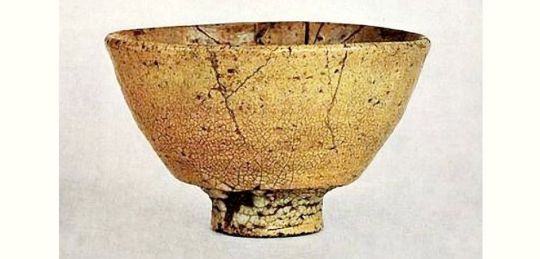
On which was resting the ori-tame [折撓] -- the word refers to a bamboo chashaku that is shaped by bending -- that was made to match the chaire. The chakin and chasen were also placed inside the chawan, as usual.

__________
*This chawan has been known as the Tsutsu-i-zutsu [筒井筒] since it was broken, by some of Hideyoshi's pages, in the 1590s.
²³Mizusashi Shigaraki [水指 シカラキ].
This was Rikyū's Shigaraki mizusashi, below.
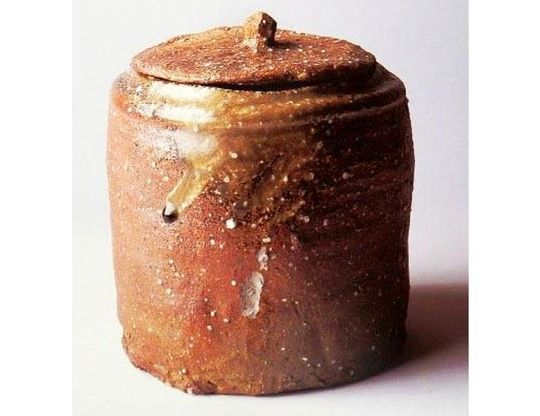
In addition to which, Rikyū would have used a take-wa [竹輪] as his futaoki, and a mentsū [面桶] as the koboshi, which he brought out from the katte at the beginning of the temae -- though these things are not mentioned in the kaiki.
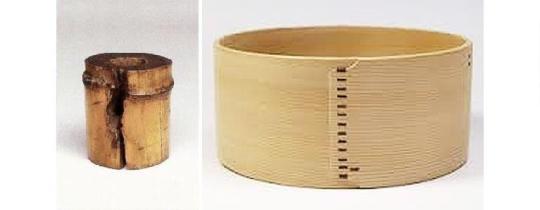
²⁴Tana ni hane [棚ニ羽].
Hane [羽], which means “feather,” refers to the habōki.
0 notes